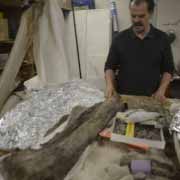Dinosaur hunter makes rare discovery in North Carolina

Andrew Heckert, a professor at Appalachian State University, is the lead author of a paper detailing the discovery of a species that went extinct some 230 million years ago. (Photo: Dale Neal, Asheville (N.C.) Citizen-Times)
BOONE, N.C. — Andrew Heckert usually heads out west when he wants to go back in time, say about 230 million years ago.
But in recent years, the Appalachian State University professor could drive down the mountain to Raleigh to discover prehistoric fossils of a previously unknown species.
Eons before human politicians, Raleigh was a swamp and home to a creature known as the aetosaur. Think of a crocodile-like reptile with spiked armor.
But these weren’t the ferocious killers that crocodiles evolved into in Africa. Aetosaurs had blunt teeth and likely feasted on plants.
“Aetosaurs are an extinct group of reptiles from the Triassic period from the lineage that eventually evolved into crocodiles,” Heckert said. “They were not dinosaurs, but superficially look like some of the much larger armored dinosaurs that would evolve later.”

Andrew Heckert looks over a fossil of the snout of a phytosaur found in a clay-mining quarry near Wadesboro, N.C. (Photo: Dale Neal, Asheville (N.C.) Citizen-Times)
Heckert is the lead author of a new article published in The Journal of Vertebrate Paleontology about the discovery of a new species of aetosaur. Heckert, along with colleagues at the North Carolina Museum of Natural History, were able to identify an entirely new genus and species of these animals that died out millions of years ago.
The fossil’s name — Gorgetosuchus pekinensis — reflects the distinctive spikes around the neck and the rock formation in which the fossils were found.
The first half of the genus name “Gorgetosuchus” comes from gorget, which is the metal neck ring that knights once sported, while “suchus” is ancient Greek for crocodile. The species name “pekinenis” refers to the Upper Pekin Formation that runs through present-day central North Carolina where the fossils were uncovered.
The discovery was made near a mining operation where huge boulders had been shoved aside to get at the clay that could be used in brickmaking.
Experts were able to see a jumble of the spikes embedded in the Triassic rock. At first Heckert thought they had part of the creature’s tail. But as they studied the spikes closer and took 3-D printed molds, Heckert realized they were looking at the other end.
“We knew this specimen was spiny, and when we put the pieces together, we saw how some of the armor completely covered the neck,” Heckert said. “So this is the Pekin Formation neck collar crocodile.”
Aetosaur fossils have been found on continents around the world. And Raleigh wasn’t exactly on the map as we’re used to. North Carolina was actually mashed up against Morocco as part of the super-continent Pangea. After the land masses drifted apart, fossils of the aetosaur have been found around the world.
“North Carolina is typically not on anybody’s list for dinosaurs, even though we’ve been finding Triassic fossils here for the past 100 years,” Heckert said.

Andrew Heckert, a professor at Appalachian State University, looks over the leg bone of a hadrosaurus that he and his students found on a field trip to Arizona. (Photo: Dale Neal, Asheville (N.C.) Citizen-Times)
Dinosaurs are likely to be found in sedimentary rock formations out west, but most every state has areas where they roamed, died and were preserved underground.
Except for Western North Carolina, where the Appalachian Mountains predate the age of dinosaurs.
“There probably weren’t any life forms with skeletons when the Appalachians were being formed, only jellyfish,” Heckert said.
Boone is home to at least three paleontologists in the geology department.
“Andy’s a great addition to the faculty,” said William Anderson, who heads the department. “He has a different way of looking for fossils, working in clay pits and sieving through sediment.”
Heckert also heads the small but impressive fossil and mineral museum that the geology department has on campus.
Heckert’s love of dinosaurs dates to his childhood in Ohio. His father and grandfather were avid rockhounds, and like most children, he was fascinated by the dinosaur fossils in the Field Museum in Chicago.
Heckert went to New Mexico University for graduate studies in paleontology. Instead of the Tyrannosaurus Rex and the huge dinosaurs of the later Jurassic Age, Heckert decided to specialize on the earlier and smaller dinosaurs that evolved during the Triassic Age.
Heckert conveys that enthusiasm to undergraduate students, leading field trips each spring for digs in Arizona.
“It’s the coolest thing when you’re out in the field, digging up these bones. You’re holding a piece of the past in your hands,” said Chelsea Vaughn, a senior from Durham.

